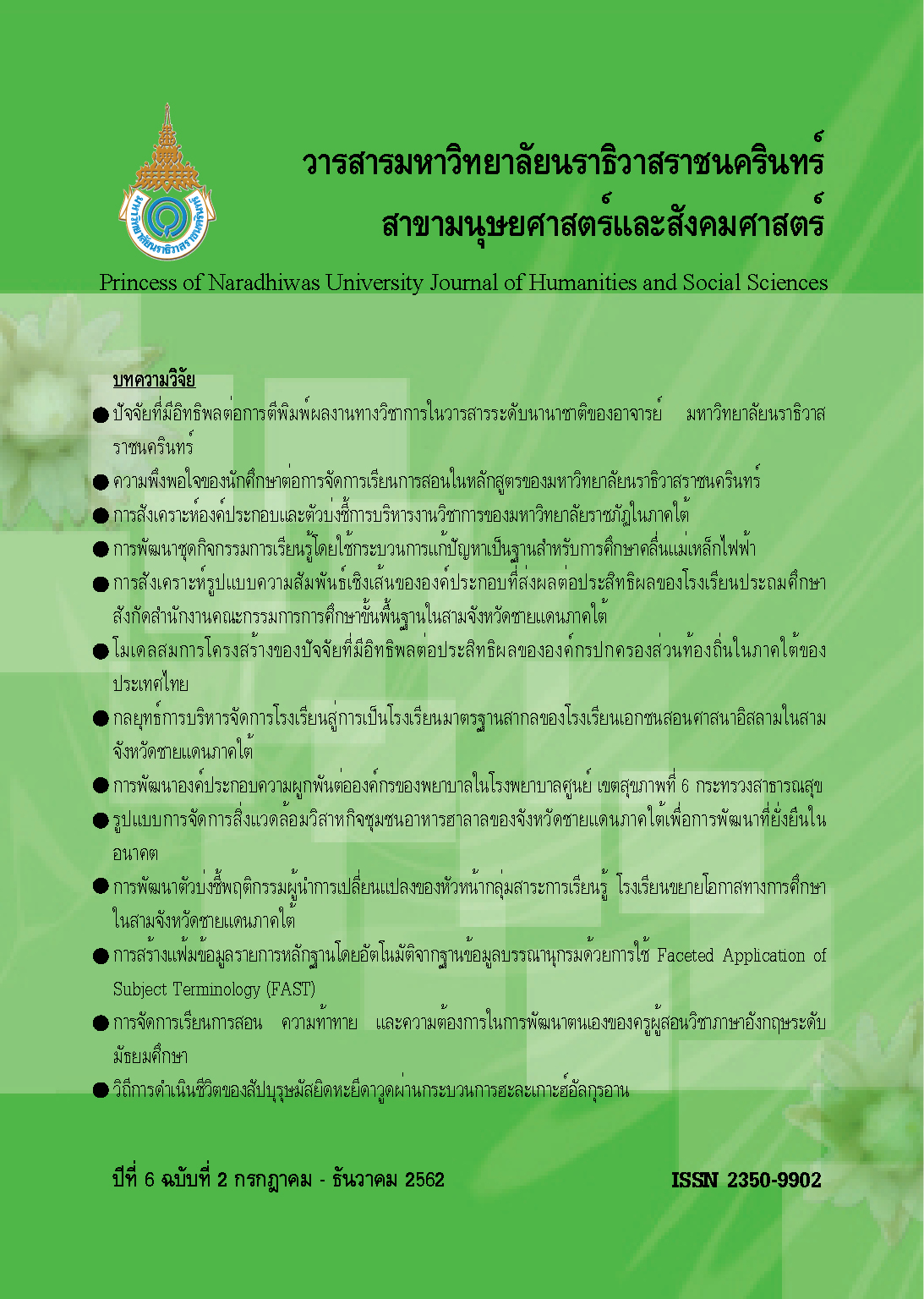Development of an Instructional Activity Package Based on the Problem-solving Process for Electromagnetic Wave Education
Main Article Content
Abstract
The objectives of this research were 1) the quality of developed instructional activity package based on problem solving process for electromagnetic wave education, 2) to test the performance of instructional activity package based on problem solving process with the standard criterion of 75/75 and 3) to evaluate the students’ satisfaction in using the instructional activity package. The samples of this study were 19 of industrial technology program in electronic and telecommunication engineering, faculty of industrial education, Rajamangala University of Technology Phra-Nakhon, first semester year 2016, by using simple purposive sampling students who registered the electromagnetic wave course. The research tools were the instructional activity package based on problem solving process for electromagnetic wave education consists of teacher’s manual, instructional package, and achievement tests. Quality measurement of the instruments was based on validity, reliability, item difficulty and discrimination. Moreover, Data was analyzed by educational statistics including the mean, standard deviation and E1/E2 efficiency.
The research results shown that 1) the quality of developed instructional activity package based on problem solving process for electromagnetic wave education was high appropriate ( =4.20, S.D.=0.21), 2) the performance (E1/E2) of developed instructional activity package was equal to 74.90/75.06 which was consistent with the standard criterion of 75/75 and 3) the students' satisfaction using an instructional activity package based on problem solving process for electromagnetic wave education was at high level ( =4.36,S.D.=0.33). The overall the developed instructional activity package based on problem solving process for electromagnetic wave education can be used effectively in the teaching of telecommunication engineering education.
Article Details
References
ชญาภา ใจโปร่ง. (2554). กิจกรรมการเรียนการสอนคณิตศาสตร์ที่เลือกใช้กลยุทธ์ในการแก้ปัญหาที่หลากหลาย เพื่อเสริมสร้างความสามรถในการแก้ปัญหาทางคณิตศาสตร์ เรื่อง ฟังก์ชัน สำหรับนักเรียนชั้น มัธยมศึกษาปีที่ 4. ปริญญาการศึกษามหาบัณฑิต สาขาวิชาคณิตศาสตร์ มหาวิทยาลัยศรีนครินทร์วิโรฒ.
ชัยยงค์ พรหมวงศ์. (2556). การทดสอบประสิทธิภาพสื่อหรือชุดการสอน. วารสารศิลปากรศึกษาศาสตร์วิจัย, 5(1), 7-20.
ทิศนา แขมมณี. (2560). ศาสตร์การสอน: องค์ความรู้เพื่อการจัดกระบวนการเรียนรู้ที่มีประสิทธิภาพ. กรุงเทพฯ : สำนักพิมพ์แห่งจุฬาลงกรณ์มหาวิทยาลัย.
ธีระเกียรติ เจริญเศรษฐศิลป์. 2559. “การศึกษาไทย 4.0 ในบริบทการจัดการศึกษาเพื่อการพัฒนาที่ยั่งยืน”. สำนักนายกรัฐมนตรี. (28 สิงหาคม): 354.
เนตรฤทัย ขันอาษา. (2558). การพัฒนากิจกรรมการเรียนรู้คณิตศาสตร์โดยใช้รูปแบบการจัดการเรียนรู้ตาม แนวคิดทฤษฎีคอนสตรัคติวิสต์และกระบวนการแก้ปัญหาของโพลยา ที่เน้นทักษะการคิดวิเคราะห์ เรื่อง
สมการเชิงเส้นตัวแปรเดียว ชั้นมัธยมศึกษาปีที่ 1, วารสารศึกษาศาสตร์มหาวิทยาลัยขอนแก่น. 38(1), 159-166.
บุญชม ศรีสะอาด. (2553). การวิจัยเบื้องต้น. พิมพ์ครั้งที่ 8. กรุงเทพฯ : สุวีริยาสาส์น
ประพันธ์ศิริ สุเสารัจ. (2556). การพัฒนาการคิด พิมพ์ครั้งที่ 8. กรุงเทพฯ: 9119 เทคนิคพริ้นติ้ง.
วารินี วีระสินธุ์, สุรพันธ์ ตันศรีวงศ์ และสมศักดิ์ อรรคทิมากูล (2558). การพัฒนารูปแบบการเรียนรู้แบบ MIASCE สำหรับการศึกษาด้านคลื่นสนามแม่เหล็กไฟฟ้า. การประชุมวิชาการครุศาสตร์อุตสาหกรรม ระดับชาติ ครั้งที่ 8. มหาวิทยาลัยเทคโนโลยีพระจอมเกล้าพระนครเหนือ,164-169.
ศิลากาญจน์ รุ่งเรือง, วีระศักดิ์ ชมพูคำ และพิชญ์สินี ชมพูคำ (2559). การพัฒนาทักษะการแก้โจทย์ปัญหา ประยุกต์คณิตศาสตร์และทักษะการทำงานร่วมกันโดยใช้กระบวนการแก้ปัญหาของโพลยาร่วมกับการ จัดการเรียนรู้แบบร่วมมือของนักเรียน ชั้นประถมศึกษาปีที่ 6. วารสารบัณฑิตวิจัย, 7(2), 107-121.
สุคนธ์ สินธพานนท์. (2558). การจัดการเรียนรู้ของครูยุคใหม่เพื่อพัฒนาทักษะของผู้เรียนในศตวรรษที่ 21. กรุงเทพฯ: 9119 เทคนิคพริ้นติ้ง.
สุราษฎร์ พรมจันทร์. (2554). รูปแบบการฝึกอบรมวิธีดำเนินการวิจัยและการจัดทำรายงานการวิจัยโดยใช้ กระบวนการสอนรูปแบบ MIAP สำหรับครูผู้สอนในสถานศึกษา, วารสารวิชาการครุศาสตร์อุตสาหกรรม พระจอมเกล้าพระนครเหนือ, 2(1), 29-34.
อลงกรณ์ พรมที และสมศักดิ์ อรรคทิมากูล. (2558). การพัฒนารูปแบบการเรียนการสอน เรื่องสมการแมกซ์เวลล์ คลื่นระนาบและกำลังไฟฟ้าของคลื่นโดยใช้รูปแบบการเรียนรู้ของ SATADE Model, วารสารครุศาสตร์ อุตสาหกรรมพระจอมเกล้าพระนครเหนือ, 6(1), 177-186.
อาคม ลักษณะสกุล, พูลศักดิ์ โกษียาภรณ์ และมงคล หวังสถิตย์วงษ์ (2556). การพัฒนารูปแบบการเรียนการ สอนทางวิศวกรรม กรณีศึกษาเรื่องระบบควบคุมแบบออโตจูน, วารสารวิจัย มข.(บศ.), 13(1), 14-27.
Kanyawit. K., Warinee, W., Pichit, U. & Somsak., A. (2016). “Development of REPEA Learning Model based on STEM-T Education.” Proceeding of the 1st international STEM education conference, 123-126. (in Thai)
Warinee, W., & Somsak, A. (2016). The Development of MIASCE learning model based on the creative problem solving process for electromagnetic wave education, Proceeding of IEEE international conference on Teaching, Assessment, and Learning for Engineering (TALE), 328-331. (in Thai)


